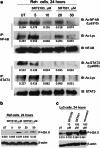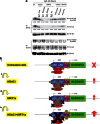SIRT1 activation enhances HDAC inhibition-mediated upregulation of GADD45G by repressing the binding of NF-κB/STAT3 complex to its promoter in malignant lymphoid cells
- PMID: 23681230
- PMCID: PMC3674366
- DOI: 10.1038/cddis.2013.159
SIRT1 activation enhances HDAC inhibition-mediated upregulation of GADD45G by repressing the binding of NF-κB/STAT3 complex to its promoter in malignant lymphoid cells
Abstract
We explored the activity of SIRT1 activators (SRT501 and SRT2183) alone and in combination with panobinostat in a panel of malignant lymphoid cell lines in terms of biological and gene expression responses. SRT501 and SRT2183 induced growth arrest and apoptosis, concomitant with deacetylation of STAT3 and NF-κB, and reduction of c-Myc protein levels. PCR arrays revealed that SRT2183 leads to increased mRNA levels of pro-apoptosis and DNA-damage-response genes, accompanied by accumulation of phospho-H2A.X levels. Next, ChIP assays revealed that SRT2183 reduces the DNA-binding activity of both NF-κB and STAT3 to the promoter of GADD45G, which is one of the most upregulated genes following SRT2183 treatment. Combination of SRT2183 with panobinostat enhanced the anti-growth and anti-survival effects mediated by either compound alone. Quantitative-PCR confirmed that the panobinostat in combination with SRT2183, SRT501 or resveratrol leads to greater upregulation of GADD45G than any of the single agents. Panobinostat plus SRT2183 in combination showed greater inhibition of c-Myc protein levels and phosphorylation of H2A.X, and increased acetylation of p53. Furthermore, EMSA revealed that NF-κB binds directly to the GADD45G promoter, while STAT3 binds indirectly in complexes with NF-κB. In addition, the binding of NF-κB/STAT3 complexes to the GADD45G promoter is inhibited following panobinostat, SRT501 or resveratrol treatment. Moreover, the combination of panobinostat with SRT2183, SRT501 or resveratrol induces a greater binding repression than either agent alone. These data suggest that STAT3 is a corepressor with NF-κB of the GADD45G gene and provides in vitro proof-of-concept for the combination of HDACi with SIRT1 activators as a potential new therapeutic strategy in lymphoid malignancies.
Figures








Similar articles
-
Resveratrol sensitizes acute myelogenous leukemia cells to histone deacetylase inhibitors through reactive oxygen species-mediated activation of the extrinsic apoptotic pathway.Mol Pharmacol. 2012 Dec;82(6):1030-41. doi: 10.1124/mol.112.079624. Epub 2012 Aug 24. Mol Pharmacol. 2012. PMID: 22923501 Free PMC article.
-
Sirtuin1 activator SRT2183 suppresses glioma cell growth involving activation of endoplasmic reticulum stress pathway.BMC Cancer. 2019 Jul 18;19(1):706. doi: 10.1186/s12885-019-5852-5. BMC Cancer. 2019. PMID: 31319814 Free PMC article.
-
SRT1720, SRT2183, SRT1460, and resveratrol are not direct activators of SIRT1.J Biol Chem. 2010 Mar 12;285(11):8340-51. doi: 10.1074/jbc.M109.088682. Epub 2010 Jan 8. J Biol Chem. 2010. PMID: 20061378 Free PMC article.
-
Redox modulation of chromatin remodeling: impact on histone acetylation and deacetylation, NF-kappaB and pro-inflammatory gene expression.Biochem Pharmacol. 2004 Sep 15;68(6):1255-67. doi: 10.1016/j.bcp.2004.05.042. Biochem Pharmacol. 2004. PMID: 15313424 Review.
-
Histone deacetylase 3 (HDAC 3) as emerging drug target in NF-κB-mediated inflammation.Curr Opin Chem Biol. 2016 Aug;33:160-8. doi: 10.1016/j.cbpa.2016.06.019. Epub 2016 Jun 29. Curr Opin Chem Biol. 2016. PMID: 27371876 Free PMC article. Review.
Cited by
-
Root Extract of Polygonum cuspidatum Siebold & Zucc. Ameliorates DSS-Induced Ulcerative Colitis by Affecting NF-kappaB Signaling Pathway in a Mouse Model via Synergistic Effects of Polydatin, Resveratrol, and Emodin.Front Pharmacol. 2018 Apr 11;9:347. doi: 10.3389/fphar.2018.00347. eCollection 2018. Front Pharmacol. 2018. PMID: 29695964 Free PMC article.
-
1-Deoxynojirimycin (DNJ) Ameliorates Indomethacin-Induced Gastric Ulcer in Mice by Affecting NF-kappaB Signaling Pathway.Front Pharmacol. 2018 Apr 19;9:372. doi: 10.3389/fphar.2018.00372. eCollection 2018. Front Pharmacol. 2018. PMID: 29725297 Free PMC article.
-
Targeting Histone Deacetylases: Opportunities for Cancer Treatment and Chemoprevention.Pharmaceutics. 2022 Jan 16;14(1):209. doi: 10.3390/pharmaceutics14010209. Pharmaceutics. 2022. PMID: 35057104 Free PMC article. Review.
-
Gadd45g insufficiency drives the pathogenesis of myeloproliferative neoplasms.Nat Commun. 2024 Apr 6;15(1):2989. doi: 10.1038/s41467-024-47297-2. Nat Commun. 2024. PMID: 38582902 Free PMC article.
-
TG2 and NF-κB Signaling Coordinates the Survival of Mantle Cell Lymphoma Cells via IL6-Mediated Autophagy.Cancer Res. 2016 Nov 1;76(21):6410-6423. doi: 10.1158/0008-5472.CAN-16-0595. Epub 2016 Aug 3. Cancer Res. 2016. PMID: 27488529 Free PMC article.
References
-
- Stimson L, Wood V, Khan O, Fotheringham S, La Thangue NB. HDAC inhibitor-based therapies and haematological malignancy. Ann Oncol. 2009;20:1293–1302. - PubMed
-
- Frye RA. Characterization of five human cDNAs with homology to the yeast SIR2 gene: Sir2-like proteins (sirtuins) metabolize NAD and may have protein ADP-ribosyltransferase activity. Biochem Biophys Res Commun. 1999;260:273–279. - PubMed
Publication types
MeSH terms
Substances
Grants and funding
LinkOut - more resources
Full Text Sources
Other Literature Sources
Research Materials
Miscellaneous

